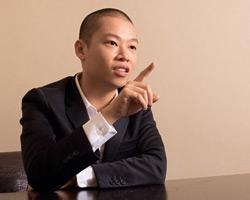(单词翻译:单击)
Where does a collection begin? In the mind and imagination of a designer, of course, but also in a physical space, an insider sanctum that is almost never seen by consumers: the office and atelier. In many ways, these private spaces reflect the choices and points of view that inform fashion as much as any runway show. If in doubt, simply consider the outtakes from a series of behind-the-velvet-curtain videos in which designers from New York to Paris invited The New York Times into their professional lives. First up: Jason Wu, who opened his namesake label in 2006 and shot to fame as the designer of Michelle Obama's inaugural gowns, in his New York office. (This interview has been edited and condensed.)
服装系列起源于何处?当然是起源于设计师的头脑和想像,但它也起源于一个物理空间,一个消费者几乎从未见过的密室:办公室/工作室。从很多方面讲,这些私人空间和时装秀一样能反映时尚选择和观点。如果你对此还有怀疑,那就来看看这一系列幕后视频:纽约、巴黎等地的设计师们邀请《纽约时报》走进他们的职业生活。首先登场的是吴季刚(Jason Wu),他在2006年开创了自己的同名时装品牌,因两次为米歇尔·奥巴马(Michelle Obama)设计就职典礼礼服而声名鹊起。当然,这两件礼服都是在他的纽约工作室里设计的(下面的访谈经过剪辑和浓缩)。

Q. How long has this been your professional home?
问:你在这里工作多久了?
A. I've been in this office three years. I always wanted to be in the garment district because I make 90 percent of my production here, so I thought it was really important that I was very close to the work, and am still close to the work, and part of New York. It feels really very New York to me. You have people hauling fabric at 8 a.m., and tons of delivery trucks, and loud sirens.
答:我在这个办公室工作三年了。之前我一直想搬到服装区,因为我90%的服装都是在这里生产的,所以我觉得离工厂很近真的很重要,我现在依然离工厂很近,同时也还在纽约市里。在我看来,这里真的很有纽约的感觉。早上8点就有人在搬布料,有很多运货卡车和喧嚣的汽笛声。
And you moved here because you outgrew your previous space?
问:你搬到这里是因为以前的地方不够用了吗?
My last studio was 3,000 square feet, and this one is 10,000 square feet, plus I have another floor, so it's six times the size maybe. My previous office was very primitive. I had painted the walls myself. I did charcoal gray and white. It was very minimal, not because we wanted it to be minimal, but because at the time we couldn't afford anything. With this office I got to kind of explore and play. When I first moved here, it had red walls with gray carpet. It was some sort of a trading firm and it was like 10 offices on this floor, so we had to take everything out.
答:我的上一个工作室有3000平方英尺,这个有10000平方英尺,另外还有一层,所以面积大概是原来的六倍。我之前的办公室非常简陋。墙都是我自己刷的。我刷成了炭灰色和白色。它是极简风格的,不是我们想让它成为极简风格,而是我们当时没钱。而这个办公室能够让我探索和玩耍。我刚搬到这儿时,墙是红色的,地毯是灰色的。好像之前是个贸易公司,这一层大概有十个办公室,所以我们必须把所有东西都扔掉。
How did you choose your personal corner in this space?
问:在这个空间里,你怎么选中了这个私人角落?
This nook felt like the most private place in the office. It just felt like it was calling my name.
答:这个角落好像是整个办公室里最私密的地方。我感觉它在呼唤我的名字。
Is it important to you to have a place to retreat?
问:有个休憩之处对你来说重要吗?
Yes. My daily life is a lot of hustling and bustling, and a lot of insane moments, especially during fashion week. But sometimes you need that moment of quietness where you put the drapes up and kind of like have five minutes of "do not disturb." Not that it really ever happens. But I do start the day everyday here with my coffee. Email, phone calls — it all happens here.
答:重要。我每天的生活都忙忙碌碌,有很多让人抓狂的时刻,特别是时装周期间。但有时你需要一个安静的时刻,可以拉上帷幕,拥有五分钟不被打扰的时间。虽然这并没有真的发生过。不过我总是在这里开始新的一天,写邮件、打电话都是在这里。
How did you choose your desk?
问:你是怎么选择书桌的?
This is a vintage desk. I like that it's kind of classic and wood and not your typical work desk. A lot of me is very traditional. I like old bones and classic furniture, and this kind of represents me very well.
答:这是个古董书桌。我喜欢古典和木头的感觉,不喜欢典型的办公桌。我很大程度上非常传统。我喜欢老东西和古典家具,这很好地代表了我。
And the chairs?
问:这些椅子呢?
These chairs are from DDC [the design firm]. I used to pass by it all the time as a student at Parsons, seven or eight years ago, and the one thing I wanted was these chairs in black and white. I finally got them.
答:这些椅子来自DDC设计公司。七八年前我在帕森斯学院就读时经常路过那里,那时候我想要的东西就包括这些黑白两色的椅子。现在我终于拥有它们了。
What's on the shelves?
问:书架上有什么?
A lot of books. I buy books every week. I guess I'm a hoarder of books, but I love the way the paper feels, and the way they look and smell. There is a little cat that represents good fortune. I've always had this affinity for cats, so my parents gave me that when I was little, and I kept it. There's a little clock, because I'm always late, so it's kind of a nice reminder.
答:很多书。我每周都买书。我觉得我是书籍囤积狂,但是我很喜欢纸的触感,喜欢它们的样子和味道。这个小猫代表好运。我一直喜欢猫,所以小时候父母给了我这个,我一直留着它。还有个小钟,因为我总是迟到,所以它是个很好的提醒。
Do you draw your collection out first, or do you design on the computer?
问:你是先把服装系列画出来,还是在电脑上设计?
I do everything by hand. Computers are only for emails. I'm a very computerless person normally. I still cut and paste and use glue and marker. Working with the hand is still the most appealing to me.
答:我什么都动手做。电脑只用来收发邮件。总的来说,我是个不用电脑的人。我仍然手动剪贴,使用胶水和记号笔。动手工作依然是我最喜欢的方式。
Is that wall made of corkboard?
问:那面墙是用软木板做成的吗?
Uh-huh. I have the need to pin everything, so you'll see there is corkboard everywhere in my studio. It's like a larger version of the fridge magnet situation, where you just put everything you know. I collect things I like to look at it, and it's kind of become my little history. I build the walls every season according to the collection. Sometimes I start with a person, sometimes with a color, sometimes with an idea and sometimes with a combination of the three. In two weeks this will probably explode with many more pictures. And then, the day after the show, I'll take it all down. It's so liberating. It's kind of the cycle of life.
答:嗯哼。我需要把所有东西都钉到墙上,所以你会发现我的工作室里到处是软木板。它像个大号冰箱贴板,我可以把我知道的所有东西都贴在上面。我收藏我喜欢观看的东西,它有点像我的小小历史。我每一季都根据服装系列来构建这个墙面。有时是某个人启发了我,有时是一种颜色,有时是一个概念,有时是以上三者的结合。在两周时间内,这面墙很可能会铺满很多图片。在时装秀的第二天,我会把它们全揭下来。有一种释放的感觉。它像是生命的轮回。
Afterward, do you keep all the research and pictures or throw them away?
问:之后,你会保留所有这些研究和图片,还是把它们都扔掉?
I file everything into folders by season. Again, I'm a bit of a hoarder. I like to keep things that I looked at or have been inspired by, because I think at some point you do want to go back and have a look. Those are moments that can't really be replaced. Like the note wall.
答:我每一季都把所有东西归档。这再次表明我有点像囤积狂。我喜欢保存我看过的或者给过我灵感的东西,因为我觉得将来的某个时刻,你会想回头看一看。那些时刻是不能被代替的。比如那面便签墙。
The note wall?
问:便签墙?
I always loved the idea of having stationery. I'm in the habit of writing notes, and when people write me notes it feels too special to throw away. I've been very fortunate to be able to meet so many different kinds of people who I never thought would a) know who I am, or b) even care. So I decided to put the notes up one section of the cork wall and not recycle them because they are something that can never be replicated again, and that is very, very dear to me. It's become a bit of a project. Those I don't take down.
答:我一直很喜欢用纸笔的感觉。我有写便条的习惯,有人给我写便条时,我会觉得很特别,不舍得扔。我觉得自己非常幸运,能遇到这么多不同的人,我以前根本没想到他们竟会知道我是谁,更别说去在乎我。所以我决定把这些便签贴在软木墙上的一块地方,再也不取下来,因为它们是不能被复制的,对我来说特别特别珍贵。它变得有点像一个艺术作品。那些东西我不会取下来。


